Prefer to listen?
This blog post forms the basis of a podcast in which you can also listen to Helen taking your through a short mindfulness practice to help you ‘arrive’, which could be used with coachees at the start of a session. Listen in here.
Integrating Mindfulness and Meditation into Coaching
Mindfulness has been a bit of a buzzword in recent years, however, the idea of mindfulness and the practice of meditation have been around for thousands of years. How does it fit in with coaching? And how can you utilise it in the coaching room, for your coachee or for your own benefit?
From stepping into a non judgmental space, creating a vision for the future, and generating new perspectives, meditation and mindfulness can be gently powerful.
By incorporating these practices into your coaching sessions, both you and your clients can experience a greater sense of clarity, presence, and emotional balance. Let’s explore what mindfulness and meditation are, their differences, and how they can enrich the coaching process.
Understanding Mindfulness and Meditation
Often used interchangeably, mindfulness and meditation are distinct yet interconnected practices:
-
Mindfulness: The researcher John Kabat Zinn, in his 1994 study, defined mindfulness as ‘the awareness that arises through paying attention on purpose in the present moment, non judgmentally’.
- Meditation, on the other hand, is a ‘practice where an individual uses a technique such as mindfulness, or focusing the mind on a particular object, thought or activity, to train attention and awareness and achieve a mentally clear and emotionally calm and stable state (Shapiro et al., 2018).
While mindfulness can be a way of life, meditation is a tool to deepen that awareness. Through regular meditation, individuals often strengthen their ability to practice mindfulness in everyday situations.
Why Use Mindfulness and Meditation in Coaching?
Mindfulness and meditation can be powerful tools for coaches . Here’s why:
- Enhanced Presence: Mindfulness helps coaches remain fully engaged and attentive with their clients, creating a non-judgmental space essential for trust and openness.
- Stress Reduction: Both coach and coachee can benefit from reduced stress levels, fostering a calm environment conducive to exploration and growth.
- Expanded Awareness: Meditation opens pathways to creative thinking and broader perspectives, helping clients move beyond limited mindsets or “blinkered” thinking.
- Improved Focus: Regular meditation trains the mind to stay present, minimising distractions and allowing for deeper conversations.
- Emotional Regulation: By assisting in the development of one’s self-awareness and emotional intelligence, mindfulness supports coaches in managing their own emotions during sessions and helps clients navigate theirs effectively.
- Additionally, neuroscience research suggests mindfulness engages the brain’s default mode network, fostering creativity and empathy. This aligns with the core objectives of coaching: generating fresh ideas and cultivating deeper understanding.
Practical Applications in Coaching
Mindfulness and meditation can be integrated into coaching in various ways, benefiting both the coach and the client:
1. Coach Preparation
Before sessions, meditation can help you center yourself, transitioning from the rush of daily life to a calm and focused coaching mindset. A simple breathing exercise or body scan can prepare you to be fully present for your client.
2. Creating a Mindful Space
You might invite your client to join you in a short meditation at the start of a session. This could be as simple as a minute of deep breathing or a guided visualisation. This helps them to be truly present, and fosters deep connection and rapport between coach and coachee.
3. Stress Management Tools
When a client is overwhelmed or anxious, mindfulness techniques can help them ground and centre themselves. Techniques like focusing on the breath or engaging the senses (e.g., noticing three things they see, hear, and feel) can quickly calm the mind.
4. Expanding Awareness
Use guided meditations to help clients explore new perspectives. For instance, a visualisation exercise could have them “float above” their situation and observe it from a broader vantage point. This can unlock insights they might not access through traditional dialogue.
5. Ending and Grounding
After a session, a short grounding meditation can help both coach and client conclude the interaction. This practice helps the coach disconnect emotionally and energetically, especially before moving to another client or task.
Tips for Coaches New to Mindfulness and Meditation
- Start with Your Comfort Zone: Choose techniques that feel natural to you, such as breathing exercises or body scans.
- Create a Script: If you’re new to guiding meditations, and even if you’re not, draft a script and practice it out loud. Then practice it with a friend or fellow coach. Adjust your pacing and tone to create a soothing, calm atmosphere.
- Contract with Clients: Always inform clients upfront if you plan to use mindfulness or meditation, ensuring they’re comfortable with these approaches.
- Practice Regularly: Develop your own mindfulness or meditation routine to deepen your understanding and effectiveness in guiding others.
- Minimise Distractions: If coaching online, remind clients to secure a quiet, pet-free space to prevent interruptions during meditative exercises.
Mindfulness and meditation are transformative tools that can enrich the coaching experience. They help coaches prepare, remain present, and create a space for clients to relax, reflect, and explore new possibilities. Whether you use these techniques as part of your coaching toolbox, use them for yourself, or offer them as a resource for recommend them for your clients’ outside of the coaching space, their benefits extend far beyond the coaching itself.
To find out more about our Doctors’ Transformational Coaching Diploma click through here



